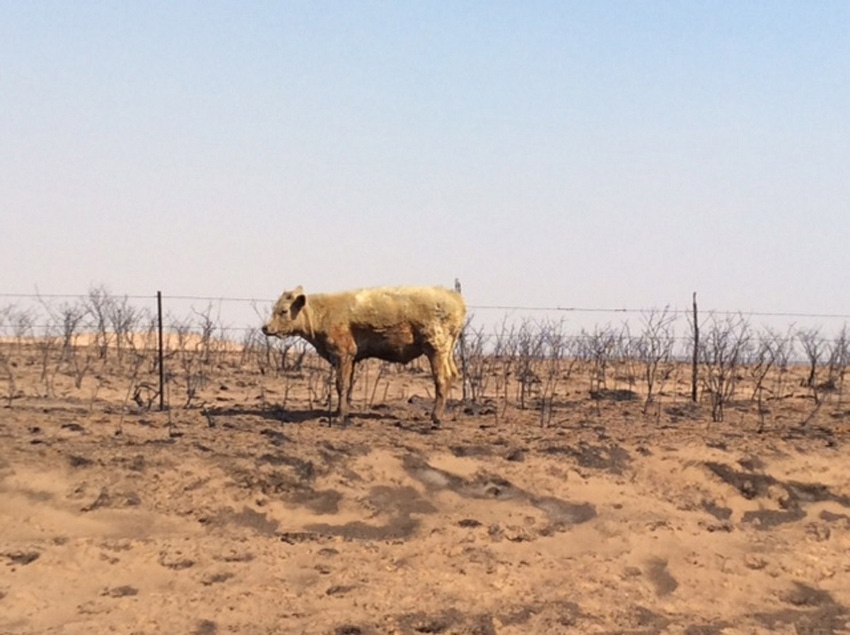
Cows and calves that survived last week’s devastating wildfires will need a significant amount of attention and medical care in coming weeks. Animals will display symptoms ranging from mild surface burns to debilitating hoof injuries. Some will recover; others will be euthanized.
Topping the list of concerns are the orphaned calves, says A.J. Tarpoff, a beef veterinarian with K-State Research and Extension.
“Regardless how they lost their mothers, we have some hungry calves that need some solid base nutrition and we need to step up and give some extra care for these young calves,” said Tarpoff. “Fostering or grafting these calves onto another mother is our best bet, but we may not have that option. The next step is turning them into bucket calves.”
The best milk replacement formulas should follow a 20-20 rule — 20 percent crude protein and 20 percent crude fat. Tarpoff said to look for animal protein bases because they work best, but the sudden demand may mean using whatever is available.
“A good frame of reference is two quarts, twice a day,” he said, “and they need access to clean, quality water at all times.”
Bucket calves can be transitioned to a starter feed relatively soon. Caregivers should offer starter feeds early on, at every feeding, and let the calf make the decision. “Once they're consuming two to three pounds a day of the starter feed for two to three days in a row, we can wean them off the milk replacement, and transition them straight onto the calf starter feed,” said Tarpoff.
Calves, heifers, cows and bulls, may suffer lingering, long-term consequences from injuries sustained in the fires. These could range from surface burns to eye and ear damage as well as respiratory damage from smoke inhalation. Tarpoff said the first concern for all these animals should be the feet. Hooves and feet may appear normal now but could succumb to latent damage. The next 10 days to three weeks are critical, and animals should be closely monitored.
“Initially, from the high temperatures of the fire we saw some separation and cracking in what's called the coronary band — that’s where the hoof transitions to the skin, where the hair starts.
CRITICAL TWO WEEKS
Over the next two weeks, even some slight damage initiated during the fire can develop into severe laminitis.”
Laminitis can include cracks in the hoof wall, and separation of the hoof from the foot. “When we see that kind of damage,” said Tarpoff, “immediate euthanasia is necessary.”
Surface burns to skin and hair are not that different from burn injuries suffered by people or other animals, Tarpoff said. Composition of the burned skin will change and eventually slough off, but the tender new skin underneath will be at risk of secondary bacterial infections. “I would highly recommend working with local veterinarians — they may have access to certain types of burn cream that can be used for some of these tender areas.”
Even minor burns can cause trouble for breeders.
“We need to pay special attention to the undersides of the animals, the udders on cows and the testicles and sheaths of our breeding bulls,” Tarpoff said. “Even if our bulls have already been reproductively tested to be able to breed this season, even if their burns aren't severe, it’d be a good idea to retest these bulls to make sure that they are fit for this upcoming breeding season.”
Perhaps the injuries that will cast the longest shadow over the lives of surviving animals are respiratory damage from heat and smoke inhalation. “Those airways are pretty sensitive to heat and smoke, and the natural mechanisms that help clean and maintain the respiratory system can sustain damage, sometimes beyond repair,” Tarpoff said. “It will take at least a month for an animal to fully heal from that kind of injury, and we’ll need to monitor that progress.”
Tarpoff said that antibiotics and respiratory drugs are available to help these animals heal from respiratory diseases and conditions, and producers shouldn’t be shy about asking for help.
“There's a lot of people donating their time, their efforts, their feed … a lot of people working together to make sure that we get back going as soon as we can, and the veterinary community is standing ready to help,” said Tarpoff.
To listen to a radio interview of A.J Tarpoff from the Agriculture Today program, click here: www.ksre.k-state.edu/news/radio-network/agtoday-mp3/031417-tarpoff.mp3
About the Author(s)
You May Also Like




